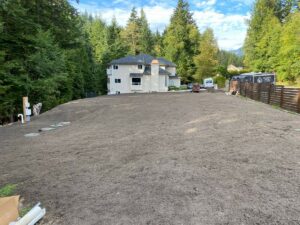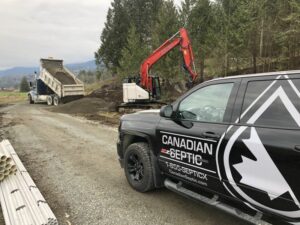The first step in installing or replacing a septic system is to have a Septic Field Design completed by a Registered Wastewater Professional.
In British Columbia, the majority of septic systems are designed and installed by Registered Onsite Wastewater Practitioners. The septic field design is just as it sounds. It is a comprehensive document that details the size of the system, the type of treatment proposed, the location of the various components, as well as the many other details that accompany a good septic design.
A septic field design must be preceded by investigative work to determine the requirements of the property and the intended use. During the course of gathering all the necessary site information, the septic field designer can determine the most suitable location for the various components of the system. On a large lot with a number of siting options, it is helpful to consider sight lines from the home, and high use areas outside the home. Nothing worse than seeing an unsightly plastic lid every time you look out your picture window, or having to move a deck or sidewalk thanks to a poorly sited tank.
Done properly, the preliminary site work will give the designer information such as how quickly the soil drains, whether there are underlying soil conditions that may prevent or hinder drainage, and also will consider distances, or setbacks as we call them to critical features on the property. These setbacks can be horizontal, such as wells, water courses, steep slopes and vertical to features such as high seasonal water table, hard pan and glaciated soil layers(dense and impermeable).
A good design will take all of the setbacks into account, and then look at most appropriate and convenient location for the family that must live with the septic system. Often poor soil conditions, setbacks, or simply aesthetic considerations require a septic designer to choose a higher level of treatment, so that the setback distances can be reduced or more siting options are made available. If there is not sufficient depth of soil to properly filter the contaminants from the waste water, the septic designer can select one of a number of treatment technologies that clean the waste water to a very high degree before it is disposed of into the soil.
When the site work and the septic system design is completed the designer will fill out a Record of Sewerage System filing form, and submit it along with the design to the local Environmental Health Authority. There an Environmental Health Officer will review the design and stamp and sign it. Only then is the septic installer authorized to proceed with construction. The installation must adhere closely to the design. If the installer is not the designer, then the installation should be a collaborative process to ensure that what goes into the ground is what was intended by the designer. Many septic system failures can be a attributed to a lack of communication, or lack of understanding by the installer of the design documents.
The Record of Sewerage System is one of the first documents requested by a building department when a contractor applies for a permit to build a new home or an addition. For this reason, it can be months between the completion of the design of the system, and the actual installation. In the interim it is very important to ensure that the area of the property allocated for the septic disposal field is not disturbed or altered in any way. If the only potential site on a difficult lot is destroyed by excavating machinery or construction traffic, a septic system design may no longer be of any use, and the result may be an expensive, undesirable compromise and a lot of bad feeling.
The last step in the septic system design is actually at the end of the installation process. Once the designer has verified that all design requirements have been carried out to his satisfaction, he will complete a Letter of Certification. This certification is submitted to the Environmental Health Authority to be signed off by them, after which the septic system is considered to authorized for use. The letter of certification must be accompanied by an accurate map of all the components of the system in order that they can always be easily located under landscaping, and a comprehensive maintenance plan. This plan will allow the homeowner and maintenance provider to know what steps are required to keep the system functioning properly and reliably for years into the future.
Contact us today to speak to one of our Septic Professionals!
- Send us an email
- Call Toll Free: 1-855-737-8429







